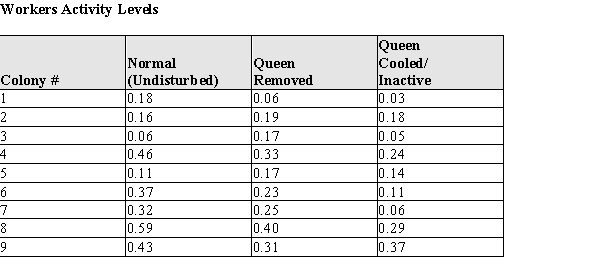In order to attribute changes in nest activity to the active influence of the queen, 9 nests were randomly selected for experimental treatment. The normal activity of the nests were measured, and treatments were administered as described below:  The data for the control treatment and each of the experimental treatments is given in the table below. The Activity Levels are the average proportion of active nest time for workers who were present in the normal and two experimental treatment periods. For example, 0.50 would mean for that nest the average amount of time the workers were actively working was 0.50 of the available time during that treatment. (The colony numbers are for identification in the table only.)
The data for the control treatment and each of the experimental treatments is given in the table below. The Activity Levels are the average proportion of active nest time for workers who were present in the normal and two experimental treatment periods. For example, 0.50 would mean for that nest the average amount of time the workers were actively working was 0.50 of the available time during that treatment. (The colony numbers are for identification in the table only.) 

(a) Construct comparative box plots of the active nest times for (a) normal, (b) Queen removed, and (c) Queen Cooled/Inactive. (Note: since the data are proportions, there are no actual units for the data.)
(b) Two current theories about the queen's interaction with workers are that (A) the queen increases worker activity by her mere presence, or (B) she increases worker activity by interacting with worker bees. Based on your plot in part (a), which theory--if either--is supported by the data? Justify your conclusion with an appropriate statistical argument.
(c) What are the mean and standard deviation of the proportion of worker activity for undisturbed wasp nests.  = s =
= s =
(d) One of the nests (Colony #4) has a proportion of worker activity of 0.46. How many standard deviations above/below the mean is the worker activity level in this nest?
(e) The biologists would like to provide some explanatory information for other scientists who would be using their new scale. They would like to state something like the following:
I. "Approximately _____ % of the undisturbed activity levels will be between −2σ and 2σ." OR
II. "At least _____ % of the undisturbed activity levels will be between −2σ and 2σ."
Based on your work so far, would you recommend using the Empirical Rule or Chebyshev's Rule to establish this percentage? Explain your reasoning in a few sentences.
(f) Using your recommended procedure from part (e) what percentage should be used to fill in the blank in the appropriate statement?
Definitions:
Bolsheviks
A faction of the Russian socialist movement that led the October Revolution in 1917, establishing a communist government and becoming the founding ruling party of the Soviet Union.
Bolsheviks
A faction of the Russian Social Democratic Labour Party led by Vladimir Lenin that seized power in Russia in October 1917, leading to the establishment of a communist state.
Provisional Government
A temporary government established to manage the transition between an existing government structure and a stable, permanent government.
October
The tenth month of the year in the Gregorian calendar, often associated with the autumn season in the Northern hemisphere and spring in the Southern hemisphere.
Q5: In a forensic study of the relation
Q13: A text file cannot be open both
Q15: Let x be the number of pages
Q16: Bootstrapping is especially useful when …<br>A) the
Q17: When performing tests of hypotheses, there are
Q25: In recent years, front-page stories of ethical
Q28: A random sample of steelhead trout was
Q39: What numbers are displayed in the list
Q54: Suppose a structure and an array are
Q55: Placing the statement Imports System.IO near the